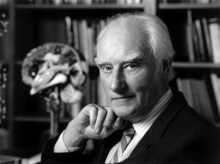Francis Crick Institute
[2] The institute is named after the molecular biologist, biophysicist, and neuroscientist Francis Crick, co-discoverer of the structure of DNA, who shared the 1962 Nobel Prize in Physiology or Medicine with James Watson and Maurice Wilkins.
[12] The creation of the UK Centre for Medical Research and Innovation (UKCMRI) was announced by the then British Prime Minister, Gordon Brown, on 5 December 2007.
[17] On 20 October 2010, the Chancellor of the Exchequer, George Osborne, confirmed that the British Government would be contributing £220 million over four years towards the capital cost of the centre.
[23] A dedication ceremony for the new building was held on 11 October 2011, attended by Mayor of London Boris Johnson, David Willetts MP and Sir Paul Nurse.
[29][30] As part of her tour, The Queen started the sequencing of the genome of the Crick's director, Sir Paul Nurse – all three billion letters in his DNA code.
As of 2024, the board is chaired by John Browne and includes Kate Bingham, Adrian Bird, Patrick Chinnery, Isabelle Ealet, Iain Foulkes, Brian Gilvary, Mene Pangalos, Geraint Rees, John-Arne Røttingen, Mary Ryan and Richard Trembath.
[41] The Francis Crick Institute is located in a state-of-the-art building, opened in 2016, built next to St Pancras railway station in the Camden area of Central London.
[42] As well as state of the art scientific equipment, much of it extremely sensitive to vibration and electromagnetic emissions, and requiring advanced methods of air handling,[43] over a third of the building is given over to plant rooms and services distribution.
[42] Laboratories within the building are arranged over four floors, made up of four interconnected blocks, designed to encourage interaction between scientists working in different research fields.
[47] 'Paradigm', a 14-metre high sculpture made of weathered steel and designed by the British artist Conrad Shawcross, was installed outside the main entrance to the institute in 2016.
[49][50] In 2010 PLP Architecture was appointed to collaborate with HOK on the building's external envelope and BMJ architects were retained as a biological research facilities consultant.
[52][53] Construction began in July 2011 and reached practical completion on time and within budget in August 2016,[42] with researchers starting work in the new building in September.



